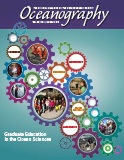Article Abstract
The objective of this paper is to look at past assessments and available data to examine the match (or mismatch) between university curricula and programs available to graduate students in the ocean sciences and the career possibilities available to those students. We conclude there is a need for fundamental change in how we educate graduate students in the ocean sciences. The change should accommodate the interests of students as well as the needs of a changing society; the change should not be constrained by the traditions or resource challenges of the graduate institutions themselves. The limited data we have been able to obtain from schools and employers are consistent with this view: desirable careers for ocean scientists are moving rapidly toward interdisciplinary, collaborative, societally relevant activities, away from traditional academic-research/professorial jobs, but the training available to the students is not keeping pace. We offer some suggestions to mitigate the mismatch. Most importantly, although anecdotes and “gut feelings” abound, the quantitative data backing our conclusions and suggestions are very sparse and barely compelling; we urge better data collection to support curricular revision, perhaps with the involvement of professional societies.

